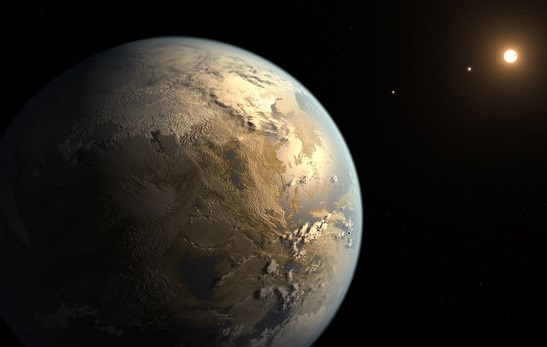We reach more than 65,000 registered users in Dec!! Register Now

First Earth-sized planet in starís "habitable zone"
- April 25, 2014
- 926 Views
- 0 Likes
- 0 Comment
In a long-awaited first, as≠tro≠no≠mers say they have found an Earth-sized plan≠et, out≠side our own so≠lar sys≠tem, or≠bit≠ing a star at a dis≠tance suit≠a≠ble to al≠low liq≠uid wa≠ter on the plan≠et's sur≠face. That means it could po≠ten≠tially host life-though no sig≠nals have been de≠tected from the body, des≠ig≠nat≠ed Kep≠ler-186f, as≠tro≠no≠mers add. ...
In a long-awaited first, as≠tro¬≠no¬≠mers say they have found an Earth-sized plan¬≠et, out¬≠side our own so¬≠lar sys¬≠tem, or¬≠bit¬≠ing a star at a dis¬≠tance suit¬≠a¬≠ble to al¬≠low liq¬≠uid wa¬≠ter on the plan¬≠et's sur¬≠face.
That means it could po­ten­tially host life-though no sig­nals have been de­tected from the body, des­ig­nat­ed Kep­ler-186f, as­tro­no­mers add. Kep­ler-186f is meas­ured to be so far away from us that even mov­ing at light speed, it would take al­most an es­ti­mat­ed five cen­turies to get there. Any radio or light signals reach­ing us from the plan­et would be that old also.
Still, ‚Äúthis is the first de¬≠fin¬≠i¬≠tive Earth-sized plan¬≠et found in the ¬Ďhab¬≠it¬≠a¬≠ble zone' around an¬≠oth¬≠er star,‚ÄĚ said Elisa Quin¬≠tana of the SETI In¬≠sti¬≠tute at NASA Ames Re¬≠search Cen¬≠ter in Moun¬≠tain View, Ca¬≠lif. She is the lead au¬≠thor of a re¬≠port on the find¬≠ings pub¬≠lished in the re¬≠search jour¬≠nal¬†Sci¬≠ence.
‚ÄúFind¬≠ing such plan¬≠ets is a pri¬≠ma¬≠ry goal of the Kep¬≠ler space tele¬≠scope,‚ÄĚ she added. ‚ÄúThe star is a main-sequence M-dwarf, a very com¬≠mon type. More than 70 per¬≠cent of the hun¬≠dreds of bil¬≠lions of stars in our gal¬≠axy are M-dwarfs.‚ÄĚ
The finding will surely shape fu­ture in­ves­ti­ga­t­ions of exoplan­ets, or plan­ets out­side our own so­lar sys­tem, with pos­si­ble Earth-like sur­faces, sci­en­tists said. The body is the fifth and out­er­most world to be de­tected in the plan­etary sys­tem of a red dwarf star known as Kep­ler-186. The star lies ap­prox­i­mate­ly in the dir­ect­ion of the con­stell­ation Cyg­nus, the Swan, in the north­ern sky on the plane of the Mil­ky Way.
Of the nearly 1,800 con­firmed exoplan­ets found in the past two dec­ades, about 20 are thought to or­bit their host star in the hab­it­a­ble zone-a range of or­bital dis­tances at which sur­face wa­ter on a plan­et with an at­mos­phere would nei­ther freeze nor boil. But all of these are larg­er than Earth, so they might be gas­e­ous plan­ets, like the larg­er plan­ets of our own so­lar sys­tem. The au­thors es­ti­mate the new­found plan­et is less then 10 per­cent wider than Earth, based on a meas­ured dim­ming of star­light from Kep­ler-186 as the plan­et passes in front of it.
The¬≠o¬≠ret¬≠i¬≠cal mod¬≠els sug¬≠gest that plan¬≠ets up to about 1.5 times as wide as Earth ‚Äúare un¬≠likely to be swathed in at¬≠mos¬≠pheres of hy¬≠dro¬≠gen and he¬≠li¬≠um, the fate that's be¬≠fall¬≠en the gas gi¬≠ants of our own so¬≠lar sys¬≠tem,‚ÄĚ ex¬≠plained Thom¬≠as Barc¬≠lay, a staff sci¬≠ent¬≠ist for the Kep¬≠ler mis¬≠sion af¬≠fil¬≠i¬≠at¬≠ed with both NASA and the Bay Ar¬≠ea En¬≠vi¬≠ron¬≠men¬≠tal Re¬≠search In¬≠sti¬≠tute.
![Kepler186f.[1]](http://machprinciple.com/wp-content/uploads/2014/04/Kepler186f.1.jpg)
So ‚ÄúKep¬≠ler-186f is likely a rocky world, and in that sense si¬≠m¬≠i¬≠lar to Ve¬≠nus, Earth and Mars.‚ÄĚ
Plan¬≠ets or¬≠bit¬≠ing red dwarf stars were tra¬≠di¬≠tion¬≠ally con¬≠sid¬≠ered not very hab¬≠it¬≠a¬≠ble. This is be¬≠cause they would have to cir¬≠cle their stars quite closely to get warmth, but this would lead to ‚Äúti¬≠dal lock¬≠ing,‚ÄĚ a situa¬≠t¬≠ion in which the same side of the plan¬≠et al¬≠ways faces the star. Then one side would pre¬≠sumably get ex¬≠tremely hot, the oth¬≠er frig¬≠idly cold.
Yet more re­cent mod­el­ing stud­ies sug­gest winds or ocean cur­rents could re­duce this prob­lem by evening out tem­per­a­ture varia­t­ions. Kep­ler-186f is al­so far enough away from its host star that it's probably not locked, the as­tro­no­mers said, and likely al­so not too vul­ner­a­ble to stel­lar flares, com­mon with dwarf stars.
As­tro­no­mers are look­ing for any sig­nals sug­gestive of life us­ing the SETI In­sti­tute's Al­len Tel­e­scope Ar­ray, which ob­serves Kep­ler can­di­date exo­plan­ets.
Ac­cord­ing to Quin­tana, at a dis­tance of 490 light-years away from us, Kep­ler-186f may be too dim for fol­low-up sur­veys to probe its at­mos­phere, even with next-genera­t­ion tele­scopes. A light-year is the dis­tance light trav­els in a year.
But ‚Äúour re¬≠search tells us that we should be able to find plan¬≠ets around bright stars that will be ide¬≠al tar¬≠gets to ob¬≠serve with James Web¬≠b,‚ÄĚ a NASA space-based tel¬≠e¬≠scope now un¬≠der con¬≠struc¬≠tion, she said. That's ex¬≠pected to be able to di¬≠rectly im¬≠age plan¬≠ets around near¬≠by dwarf stars, and break up their light to de¬≠scribe their at¬≠mos¬≠pheres.
![Post+-+April+2014+(6)+-+3[1]](http://machprinciple.com/wp-content/uploads/2014/04/Post+-+April+2014+6+-+31.jpg)
 
Source : http://www.world-science.net









